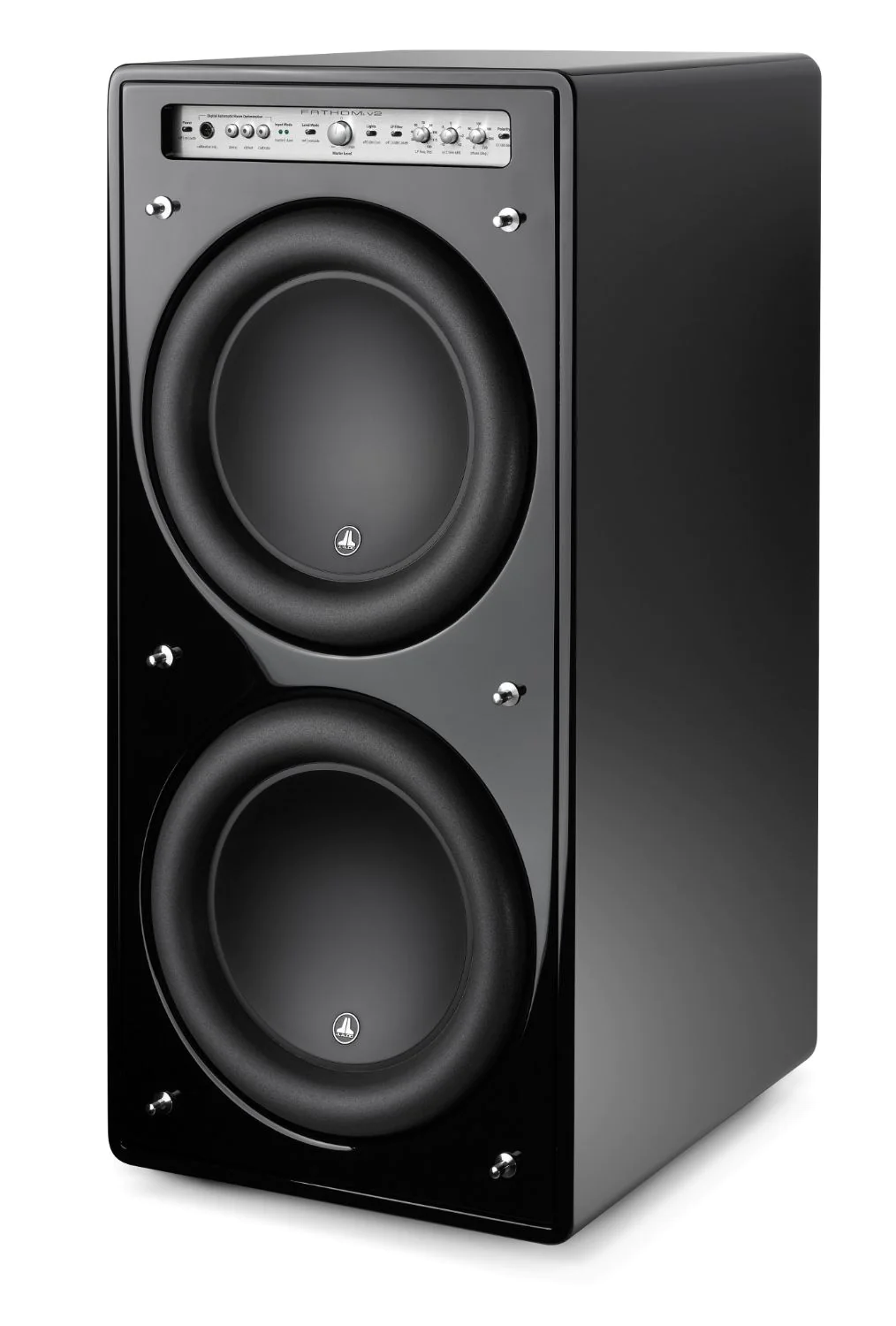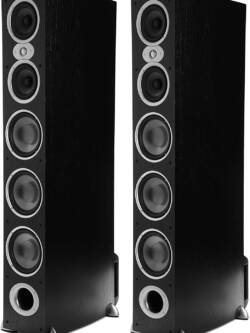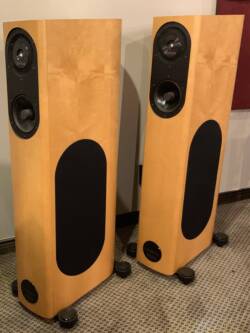JL Audio Fathom f212v2 powered subwoofer (2 available)
Original price was: R240,000.00.R156,000.00Current price is: R156,000.00.

One thing led to another: I reviewed the Fathom f113 in the September 2007 issue, and the larger Fathom f212 in the April 2010 issue, both in pairs. The two Fathoms impressed me with their bass extension, powerful impact, dynamic range, and ability to significantly increase the depth and width of the soundstage.
Which was why, after reading Kal’s January 2016 column, I called Carl Kennedy, JL’s VP of sales. I had to hear a Fathom f113v2 in my own system. Kennedy must have been expecting my call. “No,” he said, “Kal has already done the Fathom f113v2s; I’d rather you reviewed a pair of Fathom f212v2s.”
Be careful what you wish for: heavier Fathoms
Within a month, JL Audio had shipped me two Fathom f212v2s and their new CR-1 outboard crossover—total weight over 512 lbs—secured with thick metal straps to a large wooden pallet. No tool in my house could dent those straps, so I picked up a set of 18-gauge Wise W2 aviation snips at Home Depot. Their steel blades cut the thick metal straps as if they were butter. I carefully nudged the shipping cartons off the pallet and onto the garage floor.
That was the easy part. Try as I might, I couldn’t move either 256-lb speaker carton anywhere: the f212v2s stayed put as if welded to the floor. Several phone calls later, two young, muscular handymen arrived, schlepped the huge cartons upstairs, and unpacked them in my listening room. I slipped the four supplied Waxman Super Sliders under each sub to protect my wood floors, then slid them into the room’s front corners—the sweet spots where the two review samples of the first version of the Fathom f212 had sat.
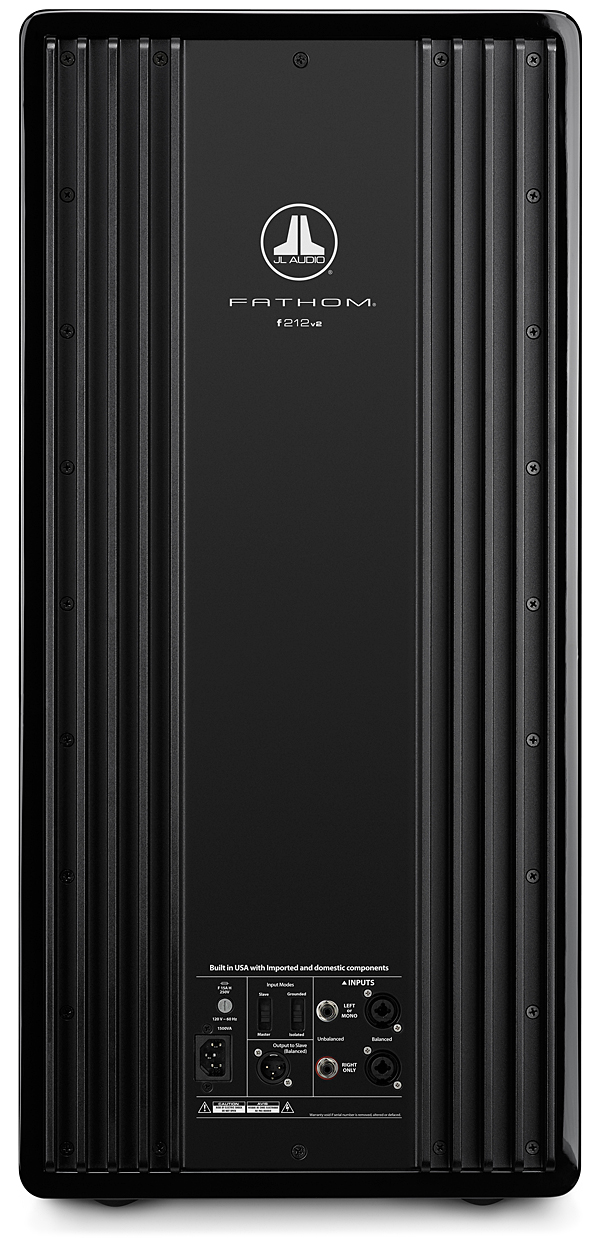
What’s new
Looking at the Fathom f212s, I was hard-pressed to see any differences between v1 and v2 that might justify the $1000 increase in price, to $7000. The changes are within. The v1’s single-band ARO equalizer has been replaced with JLA’s 18-band DARO, which covers the range from 20 to 150Hz. Kal Rubinson described DARO performing “cut-only correction, with automatic output level realignment post-EQ. Each band is adjusted independently by the DSP. In addition, microphone gain and output levels are adjusted automatically, without user effort, which results in greater ease of use and, more important, more accurate and consistent results.”
Audio line-level signals are now directed to circuit boards inside a cast-aluminum housing attached to the inside of the f212’s rear panel—they’re never routed to the control panel directly. The f212v2’s class-D internal amplifier is 20% more powerful (3600W short-term) than the v1’s, which required JLA engineers to thicken the roll surrounds of the woofers to maintain their linearity and low distortion.
The Fathom f212v2’s build quality doesn’t disappoint. It’s a massive, super-solid sub with a lustrous, High Gloss finish, equipped with high-quality Neutrik balanced connectors. All mechanical controls are of the set-and-forget type, and feel smooth and solid to the touch. The fit’n’finish are outstanding—this sub should last a lifetime.
CR-1 outboard crossover
Most aftermarket subwoofers depend on the high-pass 80Hz crossover filter built into A/V processors. But audiophile-quality two-channel preamplifiers don’t include crossover filters for the same reason they don’t have tone controls. Thus, for those with music-only systems, an outboard crossover becomes a necessity for the optimal integration of a subwoofer—it’s not an optional accessory.

The $3000 CR-1 meets this need. Its continuously variable high- and low-pass filters (30–150Hz) use 1% precision JFET-input op-amps, and polypropylene film and foil capacitors to “optimize the audio system’s spatial and spectral performance.” The low- and high-pass circuits are built around two banks of precision Linkwitz-Riley filters that can be set for 12 or 24dB/octave via a front-panel switch. Differential input technology is used to reject common-mode hum and noise on the unbalanced inputs, and independent buffering of the balanced and unbalanced outputs reduces the likelihood of noise. The rear panel offers both balanced (XLR) and unbalanced (RCA) connectors.
The CR-1’s front-panel controls are a pleasure to use. Bypass switches are prominently featured. According to Brett Hanes, JLA’s lead engineer for home products, “you can listen to the satellites in full-range (no filters applied and no subs) by hitting the CR-1’s Bypass button (its LED goes from green to red). Dealers use this one-button ‘bypass demo’ on the CR-1 as a teaching tool to easily show potential customers what a difference a subwoofer can make in their stereo system.” Indeed, being able to switch quickly, without having to detach and reinsert interconnects, helped me by speeding setup time between comparisons—important because auditory memory is so short. Four Output Muting pushbuttons on the right of the CR-1’s front panel can individually shut off each of two main speakers and each of two subs (if a button’s LED glows red, that speaker is not playing).
Setup
I set up each Fathom f212v2 without its protective grille, and with its front baffle 2.5′ behind the front baffle of the corresponding Revel Ultima Salon2—a full-range, dynamic, floorstanding speaker. The inner edges of the Salon2s’ baffles were 8′ apart, their outer edges 3′ from the sidewalls, and the centers of their baffles 7′ from my ears when I was seated. Both subs’ woofers were 9.5′ from my listening chair.
With the exception of the CR-1 crossover, I used the same system connections I had for my review of the original Fathom f212 in 2010. I ran balanced interconnects from my Bryston BP-26 preamplifier’s outputs to the CR-1’s inputs. Another pair of balanced interconnects linked the CR-1’s low-pass outputs to each f212v2’s left-channel input jack, with each subwoofer’s rear-panel switch set to Master. More balanced interconnects linked the CR-1’s high-pass outputs to the inputs of my Mark Levinson No.334 power amp, which was connected to each Ultima Salon2 with Pure Silver R50 biwire double-ribbon speaker cables.
Measurements
For this review, I used Studio Six’s iTestMic—a cost-effective, professional-grade test and measurement microphone that plugs into my iPhone 6—plus Studio Six’s Audio Tools app to run fast Fourier transform (FFT) frequency-response measurements from 8Hz to 2kHz. I placed the iTestMic–iPhone 6 combo on the back of my listening chair at ear level: 37″ above the floor. For a test signal, I used a digital file of uncorrelated pink noise, played through my Bryston BDP-2 media player.
I first put the CR-1 on full Bypass, to run FFT measurements on the Salon2s full-range, without crossover filters or subwoofers. This generated a flat room-response curve: ±3dB, 8Hz–2kHz (fig.1). To run the Fathom f212v2s solo and full-range without crossover, I plugged the Bryston preamp’s balanced interconnects into the CR-1’s Bass Management inputs, and depressed the Defeat button on each sub’s control panel to bypass its internal settings. The resulting FFT showed an irregular room response: ±6dB, 18–125Hz, with a peak at 45Hz and a bigger null at 60Hz (fig.2).



Last, I time-aligned the subs with the main speakers using the phase control on each Fathom’s control panel. Barry Ober, JLA’s home products senior tech support engineer, recommended that I use the 80Hz tone on Soundoctor‘s Test/Setup CD Version 2.7.2 to run a null test to precisely set each sub’s phase control. I did this by reversing one of the speaker cables to the Salon2 in the same channel as the sub being matched. Playing the Soundoctor tone, I placed my head between the Salon2 and its partnering Fathom f212v2. Turning the sub’s Phase knob slowly, I listened for a sudden drop in volume where the out-of-phase outputs of sub and speaker canceled out each other. I found the null point at the 20° setting. I then reversed the speaker cables on both Salon2s, to put each sub and its Salon2 back in phase.
DARO
Each sub’s DARO program was run separately. After checking that the sub was in Master mode, I connected the microphone and cable supplied with the f212v2—JL Audio’s instructions stress that this is the only mike suitable for use during DARO calibration—to the sub’s front-panel jack, placed the JLA calibration mike on the back of my listening chair at ear level, and pressed the Calibrate button. The Calibrate LED began to slowly flash red, and within seconds the sub had begun to emit pink noise at high levels. After 90 seconds, the output droned for an additional 90 seconds. The pink noise was loud enough to rattle anything in the room that wasn’t tied down, including a radiator cover at the base of the left wall. Then the Fathom f212v2 fell silent, its Calibrate LED glowing steady green. FFT measurements of the f212v2 alone after DARO tuning showed that the previous irregularities in room response had been minimized (fig.4).
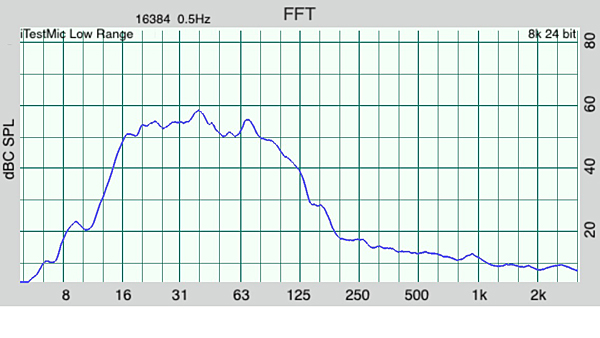
Finally, I switched on the full system. Its room response, 8Hz–2kHz, was more linear than I’d seen with the Salon2s run full-range alone (fig.5). I checked the lowest frequency bands of the half-step-spaced chromatic scale on Editor’s Choice (CD, Stereophile STPH016-2). These were sharply defined and clearly heard, as were the 40, 31, and 25Hz 1?3-octave warble tones on that CD. The 20Hz band was not only audible, it produced a strong pressure wave in the room. Playing “True Blues,” from Keith Jarrett’s The Carnegie Hall Concert (CD, ECM 1989/90) with crossover filters on revealed no discontinuities between subs and main speakers. Whether the Salon2s were run full-range or the subs and main speakers were played with the CR-1 crossover inserted, the midrange and highs remained transparent, the soundstaging wide and deep, and there was no brightening or hardening of the sound.
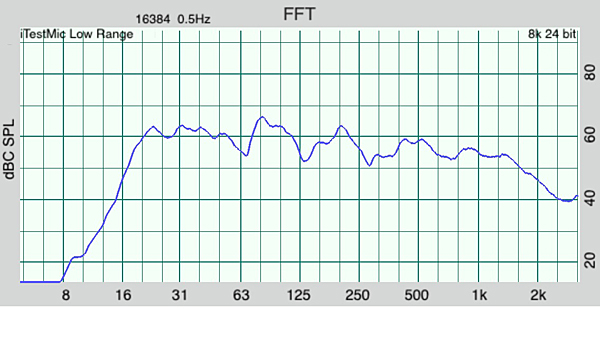
Music
The CR-1 played a crucial role in this review, letting me hear the benefits of the Fathom f212v2s and bass management in my system. When switched in, the f212v2s increased the Revel Salon2s’ bass power, dynamics, extension, and pitch definition. This was remarkable—I regard the Salon2s’ bass response as being exceptionally good, yet I heard their bass improve when the stereo subs were playing. This was evident as I listened to John Atkinson’s digital recording of the Toccata of Widor’s Organ Symphony 5, performed by Jonas Nordwall at Portland’s First United Methodist Church (24-bit/88.2kHz AIFF file). The full system better depicted the deepest (32.7Hz) notes’ depth, power, solidity, and mass, but didn’t distort or mask the upper registers’ transparency. The lowest bass notes weren’t so much heard as felt in my feet through the hardwood floor. I also heard this improvement when I played John Busby’s recording of Master Tallis’s Testament, by Herbert Howells, from Pipes Rhode Island (CD, Riago 101). With the f212v2s playing, the sustained 32Hz pedal note at the piece’s end pressurized the air and rattled loose objects.

Second, the use of two subwoofers enlarged the soundstage, increasing the three-dimensionality of images and giving a better sense of the performing space. I heard this when I played a DSD64 file of a live recording of Michael Tilson Thomas and the San Francisco Symphony performing Beethoven’s Symphony 7. Switching in the full system—two speakers and two subs—broadened and deepened the soundstage. And the f212v2’s ability to throw a huge, broad, deep soundstage revealed a three-dimensional image of tympani in the Kyrie of Ariel Ramirez’s Misa Criolla, conducted by José Luis Acejo (CD, Philips 420 955-2).
The Fathom f212v2’s bass resolution was revelatory. When I played Don Dorsey’s “Ascent,” performed by Erich Kunzel and the Cincinnati Pops on their Time Warp collection (CD, Telarc CD-80106), the JLAs’ imaging let me better distinguish the positions of the synth beats that move from side to side. Dynamics ranged from soft murmurs to a thunderous rumble as the synths blended into the sustained 31.7Hz organ note that begins Strauss’s Also sprach Zarathustra on that same disc. The deep pedal notes in Gnomus, from organist Jean Guillou’s performance of his own transcription of Mussorgsky’s Pictures at an Exhibition (CD, Dorian DOR-90117), were more focused and deep—with the Fathom f212v2s switched in, I felt them mostly through my feet as the floor shook. It surprised me that the full speakers-plus-subs system reduced in level and focused the massive, almost infrasonic organ notes in Pie Jesu, from John Rutter’s Requiem, performed by Timothy Seelig and the Turtle Creek Chorale (CD, Reference RR-57CD), to better balance the pipe organ with the soprano, chorus, and other instruments. Similarly, it was easier to follow organist Olivier Latry’s pedal notes in the first movement of Saint-Saâns’s Symphony 3, with Christoph Eschenbach conducting the Philadelphia Orchestra (SACD/CD, Ondine ODE 1094-5). These changes exemplified the quality of “better bass rather than more bass” that Kal described in his f113v2 review.
The JL Audio combo of Fathom f212v2 and CR-1 strongly benefited the quality, scale, detailing, and full power of orchestral music by enhancing the depth and width of the soundstage while revealing ambience cues. I felt and heard the jaw-tightening mass of the bass-drum strokes in the second section of Stravinsky’s The Rite of Spring, performed by Eiji Oue and the Minnesota Orchestra (DVD with 24/96 WAV file, Reference RR-70 HDCD). They burst into my listening room as dense, concussive thuds with clean, defined leading edges.
The Revel-JLA combo delivered the deepest, most powerful synthesizer chords on my soundtrack recordings, particularly the growling, explosive, mind-jarring mix of synth and percussion that drives “Assault on Ryan’s House,” from James Horner’s score for Patriot Games (CD, RCA 66051-2). The massive synth note that opens “Deeper Well,” from Emmylou Harris’s Spyboy (CD, Eminent EM-25001-2), was more focused and less blurred with the f212v2s in circuit—I could more clearly hear the words in Harris’s song, as well as the drums and guitar.
Comparison
For comparisons with the Fathom f212v2 I selected Revel’s Ultima Rhythm2 powered subwoofer for its superior build quality, inclusion of low- and high-pass filters, and similar price. At $10,000, a Rhythm2 subwoofer costs the same as one Fathom f212v2 ($7000) with CR-1 ($3000). Adding a second f212v2 brings the total to $17,000. Both subs offer high power, great bass extension, powerful internal amplifiers, clean high- and low-pass filters, and delay adjustments to time-align the outputs of subs and satellites. And both are extremely heavy, requiring two people to unpack and move them into a listening room.
The Fathom f212v2’s DARO is fully automatic; the Rhythm2’s room-optimization system requires separate FFT measurements and hand-tailoring of individual equalizer frequency and Q settings. The f212v2 has 18 bands of equalization to the Rhythm2’s 10. Unlike the Rhythm2, the f212v2 comes with four Waxman Super Sliders, a hard copy of its glossy, two-language comprehensive manual, and the calibration microphone and mike cable. The Rhythm2’s manual, test tones, and most of its control functions are available as downloads from Revel’s website.
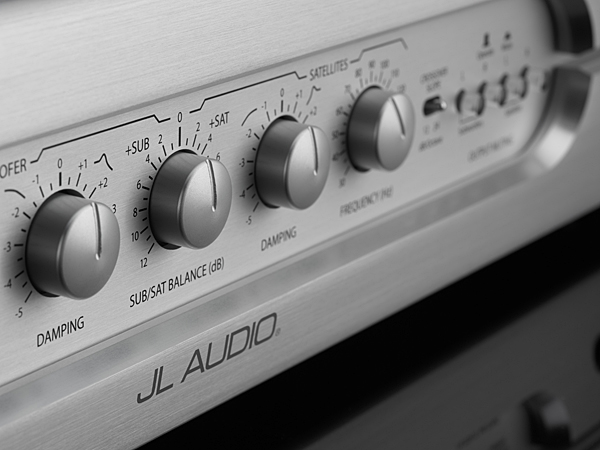
On the other hand, the Rhythm2’s single 18″ woofer offers 50% more area (254 in2) than do the f212v2’s two 12″ drivers (168 in2). The Rhythm2’s two internal amplifiers are 11% more powerful, with peak power ratings of 4kW vs the Fathom’s 3.6kW. The f212v2 is taller and weighs 28 lbs more, making it harder to move around than the Rhythm2. The Rhythm2’s Q-tuning of its equalizer bands offers a more fine-gained adjustment capability. Only the Rhythm2 can modify the sub and satellites’ output to smooth the room response.
Both subs pressurized the air and vibrated the floor of my listening room while delivering similar deep-bass extension, pitch definition, dynamic range, and slam. With some recordings, the JL Audio combo of Fathom f212v2 and CR-1 created a deeper, wider, more three-dimensional soundstage than did a single Rhythm2. Because I didn’t have a second Rhythm2, I couldn’t determine if two of them could produce the same improvements in soundstaging.
Conclusions
With the release of the Fathom f212v2, JL Audio has made important changes to the f212’s internal design, most notably the new DARO 18-band equalizer. This increased the precision and reliability of the sub’s setup, and produced easily heard and measurable improvements in deep-bass clarity. The Fathom f212v2’s sound was quicker, more solid, and had better bottom-end authority than did the v1. Two f212v2s significantly widened and deepened the soundstage, and better retrieved ambience cues. The CR-1 crossover was a godsend for blending of the outputs of speakers and subs, and it let me hear the improvements in real time when I switched in the f212v2s: increases in bass extension, pitch definition, deep-bass power, and soundstage imaging.
Those interested in buying the Fathom f212v2 should keep a few things in mind: First, this is an expensive subwoofer that will do best in large rooms. Second, it’s the heaviest and densest audio component I have encountered—don’t underestimate the challenge of moving it around. For this nosebleed price, demand that the dealer transport, unpack, and employ at least two people to move it into position. Third, realize that getting the best sound from the Fathom f212v2 requires time and patience, as well as learning how to use its controls. Set up poorly, one or two f212v2s can mess with your sound. To give you a leg up, ask the dealer to include an iTestMic, and to pay the iTunes bill for Audio Tools.
Reviewing the Fathom f212v2s let me experience once again the thrill of discovering n exceptionally powerful new subwoofer. And JLA’s CR-1 electronics crossover was a total surprise—I wondered where it had been all my life. It’s beautifully made, sonically transparent, performs a critical role in the optimal setup of subwoofers, and has ergonomic bypass and mute functions that let you immediately hear the sonic improvements of good bass management. JL Audio’s Fathom f212v2 subwoofer and CR-1 crossover are strongly recommended.

Tony O’Brien tries a monster American subwoofer for size…
JL Audio
Fathom F212v2 Subwoofer
USD $9,000 MSRP
Eclipsing many a floorstanding speaker in terms of size, intimidating is perhaps the best way to describe JL Audio’s F212v2 subwoofer. Boasting two 12-inch drivers and 3,600 watts of amplification, plus the ability to dive as low as 19Hz at -3 dB, it promises – on paper at least – to be an exciting listen.
Like all JL Audio subwoofers, the unit abstains from using off the shelf components. Drivers, enclosures and electronics are all produced exclusively in-house. Every design begins with a purpose-built subwoofer driver, developed with both a specific cabinet size and power range in mind. The driver is then optimised for linear motor and suspension performance.
As for the driver, the F212v2 uses the very same W7 platform used in JL’s Fathom and Gotham subwoofers. No less than six US patents cover the W7, the company says, including the driver’s OverRoll Surround. Unlike most drivers, which sit inside the frame, the F212v2’s is located on the outer edge of the frame. This maximises the cone’s radiating surface and provides greater excursion capability, says the manufacturer. It can place additional stress on the driver, so JL Audio’s W cone design is used, which is architecturally reinforced to allow it to withstand rapid changes in speed and direction without distortion.
The W7 drivers also employ JL Audio’s patented Engineered Lead-Wire System. Typical high excursion woofer designs either weave the signal carrying leads into the spider (the lower part of a driver’s suspension) or use flying leads. With the former, the leads are less elastic than the fabric material of the spider, causing asymmetric suspension behaviour; with the latter, the leads can mechanically whip and contact the cone or electrically short. The JL Audio approach features carefully engineered entry and exit support structures moulded into the terminals and the voice coil collar. The result, it’s claimed, is flawless high-excursion lead-wire behaviour, with outstanding reliability.
The frame itself is a rigid cast aluminium design coupled with a powerful magnet assembly. Such designs can generate excessive heat and even premature failure, the company adds. To alleviate this, the F212v2 uses JL’s Elevated Frame Cooling system, which delivers cool air from slots above the top plate directly to the voice coil. The company’s Cross-Drilled Pole Technology further enhances thermal dissipation and power handling. It’s also said to improve overall sound quality and linearity by minimising dynamic parameter shifts and power compression.
Signal processing and amplification are developed in tandem by a dedicated team of engineers. The processing or EQ used in room correction systems to flatten the response of a subwoofer can place enormous demands on an amplifier, the company ventures. For this reason, JL Audio subwoofers generally have more powerful amplifiers than most powered subwoofers. The goal is to provide linear output to the lowest content available in a recording. Hence, nearly all of the company’s designs are sealed systems with powerful amplifiers and robust drivers designed to withstand the extra power.
IN USE
I had concerns about reviewing the F212v2. At 379x812x518mm and weighing 102kg, it’s built for larger spaces than my own, and given its sheer enormity, I struggled to overcome the feeling that it would overwhelm the rest of the system. JL Audio allayed my fears somewhat by stating that while it can produce dramatic special effects, it also happily plays quiet music. You’ll only become aware of the subwoofer if you take it away, at which point the sense of body and room acoustic disappears. It’s all about control – the ability to start and stop accurately.
Packaged up, the F212v2 stands nearly a metre tall, its box sporting its own pallet and plastic feet upon which the container rests. Free of its double boxed carton and packaging foam, the big subwoofer is further protected by a cloth bag, presumably to protect the gloss finish from unwanted scratches. Unsurprisingly, wrestling the thing into place isn’t a solitary undertaking. While I had an extra set of hands for unpacking and packing the sub, I’d recommend recruiting a couple of friends. Thankfully, JL Audio has included furniture sliders, which let me slide the sub into place once free of its box. Removed, the big subwoofer rests upon four sturdy rubber feet.
As I’ve come to expect from the American company, the overall build quality was faultless. Sporting a high gloss, piano black finish, it’s a stunning looking speaker, undoubtedly high end. Be that as it may, such finishes are never my first choice for home theatres, given their reflective nature – and unfortunately, JL Audio doesn’t offer the F212v2 in other finishes.
Removing the speaker grill reveals the sub’s dual 12” drivers, nestled snuggly in their OverRoll Surrounds. It’s here you’ll also find a comprehensive range of controls for polarity, phase, low pass filter, low pass frequency, e.l.f. (extreme low frequency) Trim, input mode (master/slave), level, power and JL Audio’s Digital Automatic Room Optimisation (D.A.R.O).
The back of the big subwoofer is equally impressive; its rounded corners, height and grills giving off a distinct art deco vibe. Connections consist of balanced and unbalanced inputs and a balanced output – for using the sub in slave mode- along with input mode and grounding switches. JL’s attention to detail is impressive. In the box, you’ll find white gloves to keep the glossy finish devoid of fingerprints, furniture sliders, a leather case that houses the DARO calibration microphone, a power cord and a user manual. Wonderfully comprehensive, the latter is worthy of special mention. Not only does it clearly explain the various controls, but guides you through the setup in a logical, simple manner.
JL Audio recommends using DARO before running processor-based – or in my case receiver-based – EQ systems. Operating between 20-150Hz (1/6 octave), it provides a greater level of granularity than most parametric EQ systems. It’s also a breeze to use. Plug the supplied microphone into the input on the F212v2 and press the calibrate button – and you’re away. Mercifully DARO gives you ten seconds to leave the vicinity, and the entire process is complete in a few minutes.
Ultimately, I allowed the onboard Dirac Live/Bass Control on my JBL Synthesis SDR-35 to EQ the sub with the rest of my speakers. Replacing my usual subs, the Fathom was partnered with VAF Signature i91 front and centres and i90 rear and overhead speakers, creating a 5.1.2 Atmos layout. The remainder of the system consisted of a Sony VPL-VW270ES 4K projector, Lumagen Radiance Pro 4242, Panasonic UB-9000 4K Blu-ray player, Apple TV and a Severtson Cinegray 100” 16.9 projector screen.
THE LISTENING
The F212v2 filled my room with authoritative and visceral bass, its ability to dig into the lower octaves creating a powerful home theatre experience. Equally as impressive is its wonderfully taut, agile bass that gave very little away in terms of grip compared to the 10” drivers in my own subs.
As the Tiger tank clears the smoke in the 4K Ultra HD of Fury, the rumbling of its engines can not only be heard but clearly felt at the primary listening position. It’s a visceral performance, one that gives the Tiger the ominous presence it commands. When the Tiger and Sherman tanks finally exchange fire, the fury of the shells tore through my listening room with ease. As powerful as it is, it’s as whip-sharp as you expect a high-velocity round to be and over in a heartbeat.
Ever-present and powerful as it is, the F212v2 is also equally capable of enjoying the finer things. Its foundational bass means it revels with the discordant orchestral tones that serve to unsettle the viewer in Anabelle Creation. With the 4K Ultra HD of A Star is Born, the F212v2 was on its best behaviour. While it could have easily overwhelmed my speakers, it was more than happy to extend the range of my big bookshelves rather than swamp them. It’s not as fast as my own 10” subs, but it’s surprising just how little differentiate the two in terms of speed. Those deep notes give the stage performances a sense of presence, yet the Fathom also knows when to back off. Instruments never sound bloated nor flabby, making for a taut yet theatrical listening experience.
THE VERDICT
 The F212v2 has all the hallmarks you’d expect from a big subwoofer; impactful bass that’s capable of digging deep into those lower frequencies. Built for rooms far bigger than mine, what’s more surprising is the level of poise it possesses. The big Fathom could have easily overwhelmed my system. Instead, it served as an impressive extension to my own speakers. The consummate guest, the F212v2 understands the importance of keeping quiet just as much as it does speaking up. Top this off with first-class build and attention to detail, and JL Audio has produced another winner. If you’ve got a big room and want powerful yet articulate bass, the F212v2 may be just what you’re looking for. Either way, it comes highly recommended.
The F212v2 has all the hallmarks you’d expect from a big subwoofer; impactful bass that’s capable of digging deep into those lower frequencies. Built for rooms far bigger than mine, what’s more surprising is the level of poise it possesses. The big Fathom could have easily overwhelmed my system. Instead, it served as an impressive extension to my own speakers. The consummate guest, the F212v2 understands the importance of keeping quiet just as much as it does speaking up. Top this off with first-class build and attention to detail, and JL Audio has produced another winner. If you’ve got a big room and want powerful yet articulate bass, the F212v2 may be just what you’re looking for. Either way, it comes highly recommended.
Description
| Enclosure Type | Sealed |
| Enclosure Finish | Black Gloss |
| Frequency Response (Anechoic) | 20 – 97 Hz (±1.5dB) -3 dB at 19 Hz / 110 Hz -10 dB at 15 Hz / 157 Hz |
| Effective Piston Area (Sd) | 168 sq in / 0.1084 sq m |
| Effective Displacement | 574 cu in / 9.4 L |
| Amplifier Power | 3.6 kW RMS short-term |
| Power Mode(s) | Off, On or Automatic (Signal-Sensing) |
| Light Modes | Off, On or Dim |
| Unbalanced Inputs | Stereo or Mono (two RCA jacks) |
| Balanced Inputs | Stereo or Mono (two female XLR jacks) |
| Speaker/High-Level Inputs | N/A |
| Input Grounding | Isolated or Grounded |
| Input Modes | Master or Slave |
| Level Control | Reference (fixed gain) or Variable, from full mute to +15dB over reference gain |
| Filter Mode(s) | Low-Pass |
| Filter Slope(s) | 12/24 dB/octave |
| Filter Frequency Range | 30 Hz – 130 Hz |
| Filter Defeat Function | Yes |
| Polarity | 0 or 180 degrees |
| Phase | Variable, 0 – 280 degrees |
| Extreme Low Frequency (E.L.F.) Trim | Variable, -12 dB to +3 dB at 25 Hz |
| Line Outputs | N/A |
| Output to Slave | Balanced (one male XLR jack) |
| Calibration Mode | Digital Automatic Room Optimization (D.A.R.O.), incudes laboratory-grade microphone |
| Width (W) | 14.92 in / 379 mm |
| Height (H) | 31.96 in / 812 mm |
| Depth (D) | 20.39 in / 518 mm |
| Net Weight | 224 lb / 102 kg |
